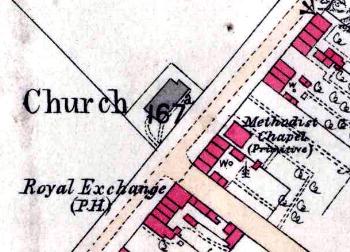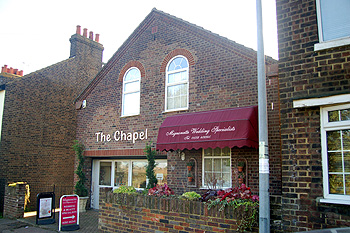Methodism in Slip End

The Primitive Methodist chapel in Slip End was built in 1868 in what is now Church Road and was part of the Luton Primitive Methodist Circuit. This became the Luton II Primitive Methodist Circuit in 1879 and Luton III Circuit in 1902. In 1932 United, Wesleyan and Primitive Methodist churches amalgamated to for the Methodist Church of Great Britain. Slip End formed part of the new Luton Circuit. In 1965 it was placed in the Luton South Circuit.
The leaflet produced for the centenary of the church in 1968 by David G. Weeks is a mine of information [ref: MB2/SE/10/1758]. The following few paragraphs are taken from his leaflet: "The chapel costing £216/15/3 was built to seat 200, which was ambitious when the population was only 600. It was opened on August 17th 1868 and a tea was held at Pepperstock Baptist Church (Co-operation between the churches even then)".
"Membership grew steadily, conditions of which were very strict. Irregular attendance at worship or class meetings, falling into debt or refusal to pay class money were all sufficient reasons for immediate removal from membership. How many members would we have today if we were equally strict?"
"Membership reached its peak in 1886 with 66 members. Nearly 200 people would attend Sunday services out of a village population of about 600. The Sunday School had 91 scholars and 20 teachers. In 1887 they raised £61 by special efforts and so paid £50 off the building debt – a great sum for those days".
"From the late 1880s things were never quite so good again. Trade in Luton was very bad. With the severe depression there were over 400 houses empty in the borough, and for the first time there was a decrease in membership. Despite this, in 1891 a mission band was formed to help at Markyate and in 1899 more land at the back of the chapel was bought".
"In 1902 the front of the chapel, previously repaired several times, was completely rebuilt which accounts for the plaque on the front of the chapel saying 1902 rather than 1868 … They also built a wall two thirds of the way up the chapel dividing it into Chapel and Sunday School which accounts for the considerable height of the Sunday School room in relation to its floor area … the choir and pulpit were completely rebuilt and the seating rearranged to give two side aisles rather than a central one. Rooms for young men's and women's classes were built at the rear".
The leaflet records the falling membership during the 20th century – 28 in 1902 and 10 in 1930, though attendances at church were always larger than the membership alone. The building needed constant repairs adding to the economic burden on the membership. This prompted talk of closure until the 1950s when youth work temporarily revived fortunes.
In the early 1970s the church obviously still had very good relations with the Pepperstock Baptists as it was proposed to sell the Slip End Methodist chapel and enter into an agreement to share Pepperstock Baptist chapel. This proposal was made following an inspection in 1972 by chartered architect Clifford W. Shrimplin reported on both premises. Of the Methodist church in Slip End he reported: "A brick and slated building about 60 years old. Principal defects are settlement cracks showing in main walls, rear annexe moving away from main building, lack of damp proof courses, repairs and renewals required to roof, gutters etc., inadequate toilet facilities, general repairs and redecoration required. To put the building in a reasonable state of repair, excluding the cost of any new toilets, would be in my opinion say, £3,000.00 - £5,000.00".
He concluded "I understand that the location of each church is relatively unimportant as regards distance from the centre of the village as in any case the straggling nature of same makes the definition of "centre of village" difficult. I would have thought, however, that Slip End was a little better sited in relation to public transport, but that there would be less noise at Pepperstock. To sum up, I would recommend that Pepperstock be retained and Slip End be sold. My principal reason for suggesting this is that whereas any alternative use for Pepperstock would, in my opinion, be refused permission by the Planning Authority and therefore become valueless, the redevelopment of the Slip End site for say residential purposes could not be refused. The money from the sale of same could be used to create good and acceptable conditions at Pepperstock".
Given that there were now less than six members of the church, of whom only two could guarantee any long term commitment, the trustees decided unanimously to close and sell the chapel and this duly happened in 1973. The building was offered for sale at £15,000 but was eventually sold for just £3,250. Happily the building survived and at the time of writing [2012] is a bridal shop.

The former Primitive Methodist chapel, September 2012
List of sources at Bedfordshire Archives:
-
MB2/SE/6/495: List of deeds to Slip End Chapel School: 1867-1899
-
MB2/SE/3/587: Collection journal: 1894-1905
-
MB2/SE/7/590: Sunday School secretary's cash book: 1905-1912
-
MB2/SE/2/585: Trust and later Church Council minutes: 1906-1922
-
MB2/SE/7/588: Sunday School treasurer's accounts: 1907-1932
-
MB2/SE/2/586: Church Council, Sunday School, Trustees minutes: 1923-1942
-
MB2/SE/3/493: Trust account book: 1927-1972
-
MB2/SE/3/589: Sunday School treasurer's accounts: 1932-1949
- MB2/SE/1/2269: Baptism register, 1943-1974
-
MB2/SE/3/494: Church account book: 1950-1973
- MB2/SE/2/2270: Trustees minute book, 1961-1974
-
MB2/SE/3/2844: Enquiries to be made at annual trustees' meeting: 1966
-
MB2/SE/6/2845: Methodist trust schedule: 1966
-
MB2/SE/10/591 and 1758: History of the church: 1968
-
MB2/SE/6/496: Survey of the chapel: 1972
-
MB2/SE/6/1759: Report on Slip End Methodist and Pepperstock Baptist churches: 1972
-
MB2/SE/6/1759: Shared use of Pepperstock Baptist church by Slip End Methodists after the closure of Slip End chapel: 1972-1978.
- MB2/SE/3/3805: Letter from W.F.Williams of Slip End to Stanley French of Luton South Circuit setting out state of affairs at Slip End, 1973